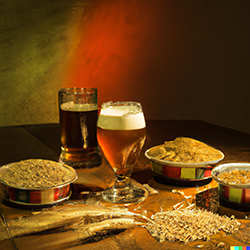Beer Grains: A Quick Overview
Posted by Matteo Lahm on 28th Feb 2023
You might be thinking about mixing things up for your next batch. Here’s a quick overview of how different grains will affect the body, flavors and colors of your beers. With the growing craft beer industry, brewers are now experimenting with different types of grains more than ever to create unique and complex flavors.
Barley is the most common grain used in beer, offering a sweet and bready flavor. It is also the main source of fermentable sugars, which are necessary for fermentation. Barley is often malted to convert the starches into sugars, which are more easily digested by yeast. Different types of barley, such as two-row, six-row, and hull-less, impart different flavors and colors. Two-row barley is highly favored by brewers due to its higher protein and lower husk content, while six-row barley is cheaper and has a higher husk content. Hull-less barley lacks a hull and will give your beer a brighter color and cleaner flavor.

Rye’s popularity is due to its spicy and earthy flavor. It is also used to add a hint of sweetness and a dry finish. Rye is often used in small quantities due to its high husk content, which can lead to astringency if used in large amounts.
Wheat is another common grain used in beer, offering a light and bready flavor. Wheat is often used in German-style wheat beers, providing a cloudy appearance and a tart, refreshing taste. It is also used in Belgian-style beers, adding a spicy and fruity flavor.
Oats are used in some beers to add a creamy and smooth mouthfeel. Oats are also used to lighten the color of your beer and add a hint of sweetness. Oats are also typically used in small amounts due to their high husk content, which like rye can lead to astringency if you use too much.
Rice is a grain that is commonly used in beer to lighten the color and add a crisp, clean flavor. It is often used in Japanese-style beers, such as sake, to add a light and dry finish.
You can also use corn and sorghum. Each adds its own unique flavor and character to your beer. Corn adds a sweet, malty flavor to beer that is similar to a light caramel. Sorghum adds a light, grainy flavor with a hint of sweetness. Sorghum has an additional advantage for those who are sensitive to gluten, because it is gluten free. You can also reduce the amount of gluten by adding White Labs Clarity Firm.

Of course, combinations of different grains will produce increasing complexities in your beers. Common mixing ratios for primary grains like malted barley, wheat, and rye depend on the style of beer being brewed. For example, in a German-style Hefeweizen, the ratio is typically 60% malted barley, 30% wheat, and 10% rye. This ratio will produce a beer that has a light, fruity flavor with a slightly spicy character. In a Belgian style Saison, the ratio is typically 50% malted barley, 20% wheat, and 30% rye, producing a beer with a slightly sweet and spicy flavor, with hints of citrus and pepper. In an American style Pale Ale, the ratio is typically 80% malted barley, 10% wheat, and 10% rye, which makes a crisp, hoppy flavor with a slight malty sweetness.
In conclusion, the grains you choose to make your beer and how you combine them will have a big impact on your flavor, color, and body. Different types of grains impart unique flavors and characteristics, allowing you to create unique and complex beers. Good luck!

